Ceramic Vs Stainless Steel Cookware: Which One You Should Buy?
Time of issue: 2024-04-22 23:10:33- What Is Ceramic Cookware?
- Ceramic Cookware Pros and Cons
- What Is Stainless Steel Cookware?
- Stainless Steel Cookware Pros and Cons
- 15 Comparison between Ceramic Vs Stainless Steel Cookware
- Cooking Surface
- Weight
- Maintenance
- Environmentally Friendly
- Special Cooking Needs
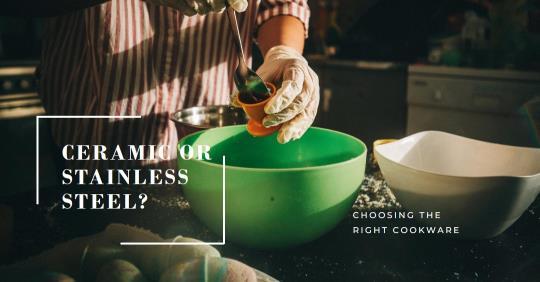
Are you thinking about getting new cookware for your kitchen? When comparing ceramic vs stainless steel cookware, it might be tough to choose between the two due to their relative strengths in terms of longevity, versatility, and cooking performance. Okay, then, let's break it down.
Avoiding the use of dangerous chemicals is just one of the many benefits of nonstick ceramic cookware over traditional nonstick coatings. A great option for low-fat cooking and cleanup, though you should be careful not to scratch or chip it.
The opposite is true for stainless steel cookware, which is impervious to rust, scratches, and stains. With this tool, you can cook at high temperatures, sear, and get that professional finish.
In order to help you make an informed decision, we will compare and contrast stainless steel vs ceramic cookware, paying special attention to the many benefits and drawbacks of each material.
What Is Ceramic Cookware?
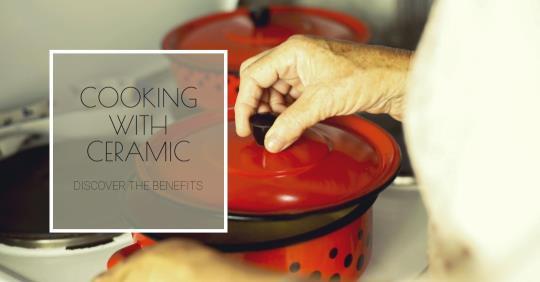
The nonstick properties and safety aspects of ceramic cookware have contributed to the rise in popularity of this food preparation material. The use of glaze prevents food from sticking to ceramic cookware, which is constructed from natural components such as sand and clay among other things. In addition to making cleanup a breeze, this nonstick surface makes it possible to eliminate the need for unhealthy cooking methods that include the use of oils and fats.
In addition, ceramic cookware, in contrast to conventional nonstick coatings, does not contain any of the hazardous chemicals that are typically utilized in the production of nonstick cookware. Because of its versatility, it may be utilized on a variety of stovetops, including electric, gas, and induction stovetops, among others. Despite the fact that ceramic cookware often has a long lifespan, it is essential to take care not to damage or shatter the covering for the appliance.
Ceramic Cookware Pros and Cons
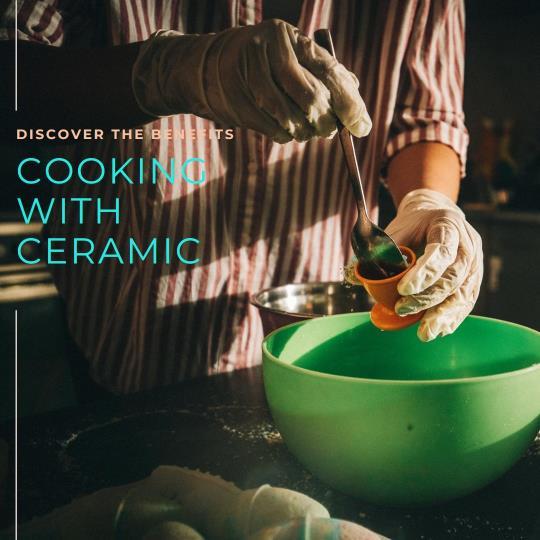
Considering ceramic cookware for your kitchen? Here's a breakdown of its advantages and disadvantages:
| Pros | Cons |
| Nonstick surface reduces oil usage | Prone to chipping and scratching |
| Easy to clean and maintain | Limited heat resistance, may not be suitable for high-temperature cooking |
| Free from harmful chemicals like PFOA and PTFE | Requires gentle handling to prevent damage |
| Versatile, suitable for various cooking methods | Durability may vary depending on quality |
| Eco-friendly materials | Some models may have a shorter lifespan |
What Is Stainless Steel Cookware?
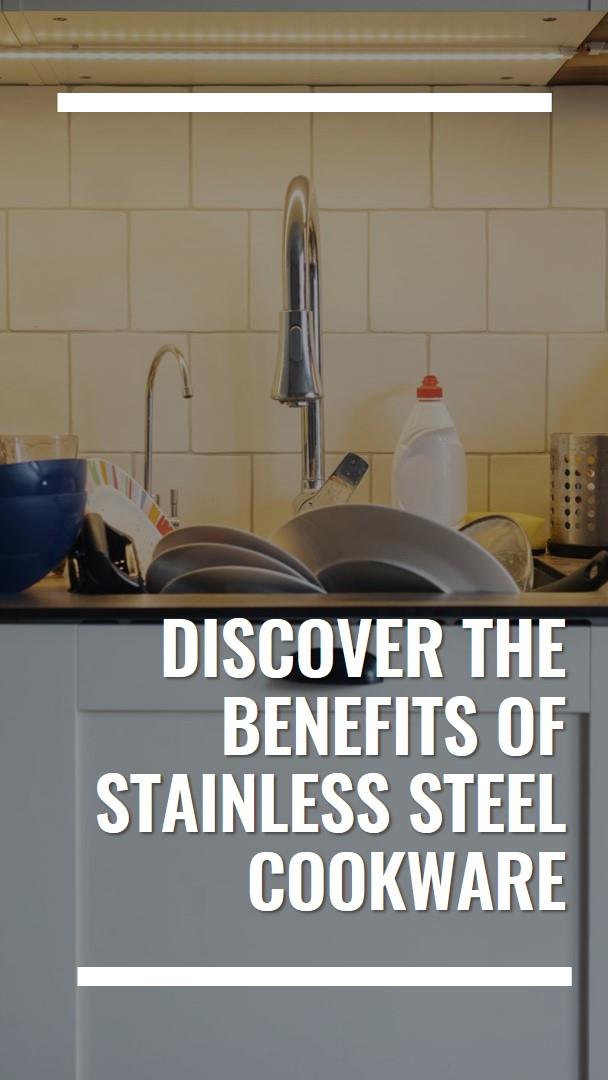
Stainless steel cookware is a staple in kitchens across the globe due to its durability, versatility, and sleek design, which are widely prized. This type of cookware is typically made from an alloy of steel and chromium, but it may also contain nickel or manganese. Chromium, when added to cookware, forms a protective layer on the surface, making it resistant to rust, corrosion, and stain damage.
Stainless steel cookware is famously good at transmitting heat evenly, making it suitable for a wide range of cooking methods like sauteing, searing, and simmering. You may use it to cook acidic ingredients like tomatoes or vinegar-based sauces without worrying about adding a metallic flavor to your dish because it is non-reactive.
Stainless Steel Cookware Pros and Cons

Considering stainless steel cookware for your kitchen? Here's a comparison of its advantages and disadvantages:
| Pros | Cons |
| Exceptional durability | Lack of nonstick properties |
| Resistant to rust, corrosion, and staining | Requires oil or butter for nonstick cooking |
| Even heat distribution | Higher initial cost compared to some alternatives |
| Non-reactive surface, safe for cooking acidic foods | Can be prone to food sticking and burning |
| Long lifespan, can last for generations | May require more effort to clean and maintain |
15 Comparison between Ceramic Vs Stainless Steel Cookware

Durability
The dependability and longevity of your kitchen essentials are directly proportional to the durability of the cookware you select. There are several benefits and drawbacks to utilizing ceramic or stainless steel cookware, both of which offer varying levels of durability.
| Durability Aspect | Ceramic | Stainless Steel |
| Description | Susceptible to chipping and scratching over time. | Known for exceptional durability and resistance to rust and corrosion. |
Although ceramic cookware is easy to clean and nonstick, it is prone to chipping and scratching with continuous use. Stainless steel cookware, on the other hand, has an excellent reputation for durability due to its resistance to rust, corrosion, and damage.
Heat Conductivity
Heat conductivity is crucial for achieving evenly cooked meals without hot spots. Ceramic and stainless steel cookware exhibit different heat conductivity properties, influencing cooking performance.
| Heat Conductivity Aspect | Ceramic | Stainless Steel |
| Description | May result in uneven heat distribution during cooking. | Offers even heat distribution, ensuring consistent cooking results. |
While ceramic cookware may sometimes lead to uneven heat distribution, stainless steel cookware excels in providing uniform heat, allowing for precise cooking control and consistent results.
Nonstick Properties
Nonstick properties simplify cooking and cleaning tasks, making them desirable features for many home cooks. Ceramic and stainless steel cookware offer different approaches to achieving nonstick surfaces.
| Nonstick Properties Aspect | Ceramic | Stainless Steel |
| Description | Boasts a nonstick surface, reducing the need for excessive oil or butter. | Lacks inherent nonstick properties, potentially requiring additional oil or butter for cooking. |
Ceramic cookware provides a nonstick surface, reducing the need for additional oils, while stainless steel cookware may require added fats to prevent sticking, as it doesn't possess built-in nonstick properties.
Versatility
Versatility in cookware allows for a wide range of cooking techniques and recipes. Ceramic and stainless steel cookware offer diverse applications to meet various culinary needs.
| Versatility Aspect | Ceramic | Stainless Steel |
| Description | Best suited for low to medium heat cooking methods. | Versatile and suitable for a wide range of cooking techniques, including high-heat cooking. |
While ceramic cookware excels in low to medium heat cooking, stainless steel cookware is adaptable to high-heat cooking methods, offering versatility for different culinary preferences.
Ease of Cleaning
Ease of cleaning is essential for maintaining cookware and ensuring hassle-free meal preparation. Ceramic and stainless steel cookware present different considerations regarding cleaning and maintenance.
| Ease of Cleaning Aspect | Ceramic | Stainless Steel |
| Description | Easy to clean but requires careful handling to prevent damage. | May require more effort to clean and maintain, particularly if food sticks. |
While ceramic cookware is generally easy to clean, it necessitates gentle handling to avoid chipping or scratching. Stainless steel cookware may require more attention during cleaning, especially if food residue adheres to the surface.
Safety
Safety is paramount when selecting cookware, ensuring that food is prepared without compromising health. Ceramic and stainless steel cookware offer different safety considerations for conscientious home cooks.
| Safety Aspect | Ceramic | Stainless Steel |
| Description | Free from harmful chemicals like PFOA and PTFE, ensuring food safety. | Generally safe for cooking, but quality may vary depending on manufacturing processes. |
Ceramic cookware provides peace of mind by being free from harmful chemicals, while the safety of stainless steel cookware depends on its manufacturing quality and adherence to safety standards.
Longevity
Longevity is a key factor influencing the value and lifespan of cookware investments. Ceramic and stainless steel cookware exhibit different durability levels, impacting their longevity in the kitchen.
| Longevity Aspect | Ceramic | Stainless Steel |
| Description | Lifespan may vary depending on quality and usage habits. | Known for its long lifespan and ability to last for generations with proper care. |
Ceramic cookware's lifespan is influenced by factors such as quality and usage, whereas stainless steel cookware is renowned for its durability and potential to endure generations with appropriate maintenance.
Appearance
The appearance of cookware can enhance the aesthetic appeal of the kitchen while reflecting personal style preferences. Ceramic and stainless steel cookware offer distinct visual characteristics, contributing to the overall ambiance of the cooking space.
| Appearance Aspect | Ceramic | Stainless Steel |
| Description | Offers colorful and decorative options to enhance kitchen aesthetics. | Boasts a sleek and modern appearance, complementing most kitchen styles. |
Ceramic cookware adds vibrancy and personality to the kitchen with its colorful designs, while stainless steel cookware exudes a contemporary elegance that blends seamlessly with various kitchen decor styles.
Price
Price considerations play a significant role in the decision-making process when purchasing cookware, balancing budget constraints with desired quality and features. Ceramic and stainless steel cookware offer different price points, catering to diverse consumer preferences.
| Price Aspect | Ceramic | Stainless Steel |
| Description | Generally more budget-friendly compared to stainless steel cookware. | Higher initial cost, but offers long-term value due to its durability. |
Ceramic cookware provides an accessible entry point for budget-conscious consumers, while stainless steel cookware may require a higher initial investment, justified by its exceptional durability and long-term performance.
Cooking Performance
Cooking performance directly impacts the outcome of culinary endeavors, influencing food taste, texture, and overall cooking experience. Ceramic and stainless steel cookware offer distinct performance attributes suited to different cooking techniques and preferences.
| Cooking Performance Aspect | Ceramic | Stainless Steel |
| Description | Ideal for gentle cooking techniques and delicate dishes. | Excels in high-heat cooking methods, such as searing and browning. |
Ceramic cookware shines in gentle cooking methods, preserving the delicate flavors and textures of dishes, while stainless steel cookware thrives in high-heat cooking scenarios, facilitating precise browning and searing for professional-quality results.
Cooking Surface
The cooking surface of cookware influences food flavor, texture, and compatibility with various ingredients. Ceramic and stainless steel cookware offer different surface properties, impacting cooking outcomes and culinary versatility.
| Cooking Surface Aspect | Ceramic | Stainless Steel |
| Description | Non-reactive surface, safe for cooking acidic foods. | Non-reactive surface, suitable for cooking a wide range of ingredients. |
Ceramic cookware's non-reactive surface ensures that it won't impart any metallic taste to acidic dishes, preserving food flavor and integrity. Stainless steel cookware also provides a non-reactive surface, accommodating various ingredients without affecting taste or quality.
Weight
Cookware weight influences ease of handling, storage, and maneuverability during cooking tasks. Ceramic and stainless steel cookware exhibit different weight characteristics, impacting user comfort and kitchen functionality.
| Weight Aspect | Ceramic | Stainless Steel |
| Description | Typically heavier than stainless steel alternatives. | Lightweight and easy to handle, even for larger pots and pans. |
Ceramic cookware tends to be heavier than stainless steel counterparts, which may affect ease of handling, especially when dealing with larger or filled pots and pans. In contrast, stainless steel cookware offers lightweight construction, enhancing user comfort and maneuverability during cooking tasks.
Maintenance
Maintenance requirements influence the ongoing care and upkeep of cookware, ensuring longevity and performance over time. Ceramic and stainless steel cookware present different maintenance considerations, affecting user convenience and satisfaction.
| Maintenance Aspect | Ceramic | Stainless Steel |
| Description | Requires gentle handling to avoid chipping and scratching. | Relatively low maintenance, may require occasional polishing for appearance upkeep. |
Ceramic cookware demands careful handling to prevent damage such as chipping or scratching, prolonging its lifespan and appearance. Meanwhile, stainless steel cookware offers straightforward maintenance, with occasional polishing to maintain its sleek appearance being the primary concern.
Environmentally Friendly
The environmental impact of cookware production and disposal is an important consideration for eco-conscious consumers. Ceramic and stainless steel cookware offer different environmental attributes, influencing sustainability and ecological responsibility.
| Environmental Aspect | Ceramic | Stainless Steel |
| Description | Made from natural materials, offering an eco-friendly choice. | Recyclable and sustainable material, contributing to environmental responsibility. |
Ceramic cookware is crafted from natural materials, making it a sustainable and environmentally friendly option. Stainless steel cookware, meanwhile, is recyclable and contributes to resource conservation, aligning with eco-friendly practices.
Special Cooking Needs
Tailoring cookware to specific cooking preferences and dietary requirements enhances culinary satisfaction and versatility in the kitchen. Ceramic and stainless steel cookware offer unique advantages suited to different cooking styles and special needs.
| Special Cooking Needs Aspect | Ceramic | Stainless Steel |
| Description | Ideal for those seeking nonstick properties without the use of chemicals. | Versatile option suitable for professional chefs and home cooks, accommodating various cooking styles and preferences. |
Ceramic cookware provides a nonstick cooking surface without the use of chemical coatings, making it suitable for health-conscious individuals. Stainless steel cookware offers versatility and adaptability, catering to diverse cooking styles and preferences, making it a favorite among professional chefs and home cooks alike.
Tips For Taking Care of Your Ceramic Cookware
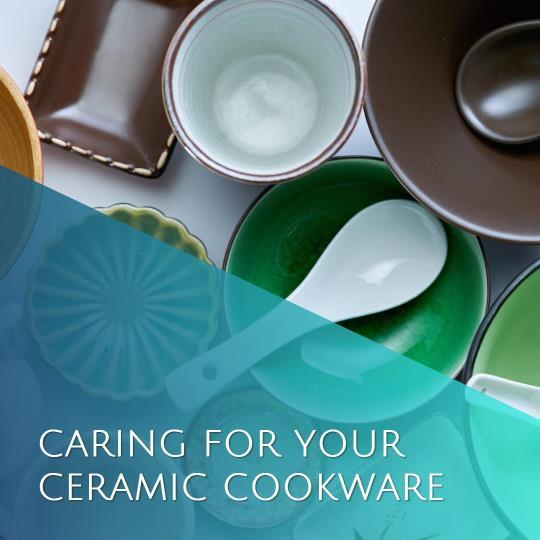
If you want your ceramic cookware to look good and perform well for years to come, proper maintenance is key. Make sure you follow these key rules if you want your ceramic cookware to stay perfect for a long time:
Step 1: Handwashing
The first rule of ceramic cookware is to wash it by hand after each usage. To wipe the surface delicately, use a mild dish soap and a soft sponge or towel. The ceramic covering is delicate and should not be cleaned with harsh scrubbers or abrasive cleaners.
Step 2: Avoid High Heat
Maintaining low to medium heat is ideal for ceramic cookware. Because they can accelerate the ceramic coating's degradation, high temperatures should be avoided at all costs.
Step 3: Use Wooden or Silicone Utensils
To avoid damaging ceramic cookware, use silicone or wooden utensils instead of metal ones. Using metal utensils on ceramic surfaces can damage them and reduce their nonstick properties.
Step 4: Avoid Metal Abrasives
Ceramic cookware is extremely delicate and should not be cleaned with harsh scrubbers or metal scouring pads. Using these abrasive materials on the surface could lead to scratches and a decrease in its performance.
Step 5: Season Occasionally
Ceramic cookware that you wish to maintain its nonstick properties may benefit from an occasional seasoning. Apply a thin coating of cooking oil to the surface and gently heat it to season the pan.
Step 6: Cool Before Cleaning
You shouldn't try to clean your ceramic cookware until it has cooled completely. Ceramics are susceptible to thermal shock, which can occur as a result of abrupt changes in temperature.
Step 7: Store Properly
It is critical to take measures to protect your ceramic cookware from damage. Heavy objects can chip or crack if stacked on top of each other, thus it's best to avoid doing that.
Step 8: Inspect Regularly
Inspecting your ceramic cookware for signs of wear and damage should be a regular part of your maintenance routine. Look for faults that could affect its performance, like chips, scratches, or any other unusualities. Take care of or repair any broken objects.
Tips For Taking Care of Your Stainless Steel Cookware
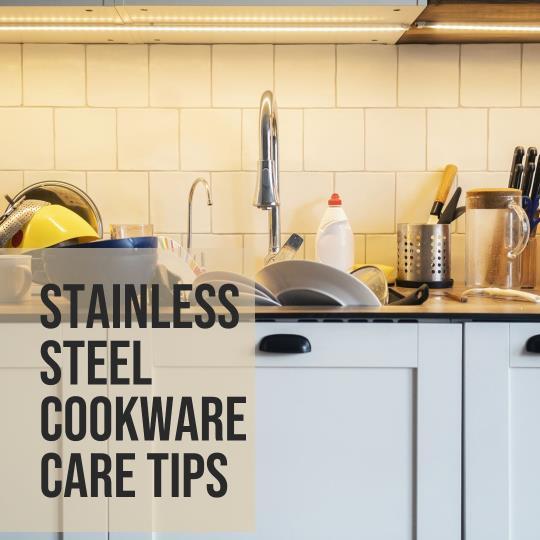
You can extend the life of your stainless steel cookware and keep it working well by giving it regular maintenance. Stainless steel cookware maintenance is easy with our all-inclusive guide:
Step 1: Handwashing
To begin, wash the stainless steel cookware by hand after every use. To clean it gently, use a sponge or towel dampened with gentle dish soap. The stainless steel finish is delicate and can be easily scratched by abrasives like steel wool.
Step 2: Towel Drying
To avoid water stains and mineral deposits, be sure to towel dry your stainless steel cookware after washing. If you let water air dry, the stainless steel could have ugly stains.
Step 3: Seasoning (Optional)
If you want your stainless steel cookware to be even more nonstick, season it every so then. Lightly heat a thin coating of oil and apply it to the surface to form a protective barrier.
Step 4: Removing Stubborn Stains
After soaking the afflicted cookware in warm, soapy water for a few hours, gently clean it with a nonabrasive sponge or brush to remove stubborn stains or burnt-on food residue.
Step 5: Avoid High Heat
It is important to avoid subjecting stainless steel to extremely high temperatures for extended periods of time, since this might result in discoloration or warping of the material when exposed to such temperatures. For optimal results, use heat settings in the low to medium range.
Step 6: Use Wooden or Silicone Utensils
To avoid damaging stainless steel cookware, use utensils made of wood or silicone. The stainless steel surface is vulnerable to scratches from metal utensils.
Step 7: Store Properly
In order to prevent the accumulation of moisture, which can result in rusting, you should store your cookware made of stainless steel in a room that is dry. For the sake of avoiding scratches and dents, do not stack heavy objects on top.
Step 8: Polishing
To maintain the brightness and brilliance of your stainless steel cookware, polish it occasionally using a stainless steel cleaning or polish. To get the most out of it, follow the directions on the packaging.
Final Thought : Ceramic Vs Stainless Steel Cookware | Which One You SHould Buy
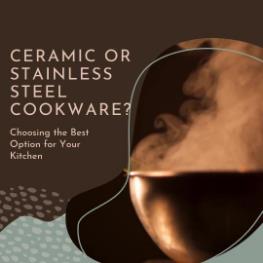
People have been arguing for a long time about whether ceramic vs stainless steel cookware is better. In the end, it comes down to personal preference and what each kitchen needs. Home cooks who care about their health and like both style and function will love ceramic pans as a food surface because they are easy to clean and have patterns that look good. But stainless steel pans are great for people who value dependability and accuracy when cooking because they last a long time, can be used in many ways, and work at a professional level.
When you cook, it's important to have good tools. We at GlobalReachCeramic.com know this. Check out our large selection of high-quality ceramic vs stainless steel cookware, which was chosen with care to meet the needs of various recipes and individual tastes. You need our high-quality tools if you want to take your cooking to a whole new level and always make dishes that make your mouth water.
Check out GlobalReachCeramic.com right now to find the perfect cookware to go with all of your cooking activities.
RECENT POSTS
- Stoneware vs Porcelain vs Earthenware: Quick Decision Guide
2025-10-09
- Are Ceramic Glazes Food Safe? The Truth Behind the Shine
2025-10-09
- Christmas Decoration Trends That Wow Every Guest
2025-09-18
- Halloween Decoration Trending Ideas with Ceramics For 2025-26
2025-09-18
- Top 10 Custom Plant Pots: Add Personality to Your Plants
2025-09-18
- Custom Incense Holders : The Ultimate Guide in 2025
2025-08-22
- Customized Ashtrays as Wedding Favors: A Unique Touch for Guests
2025-08-22
- 15 Best Custom Flower Vase Design Ideas To Enhance Your Decor
2025-08-05









